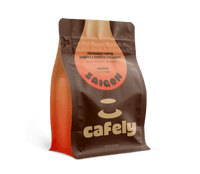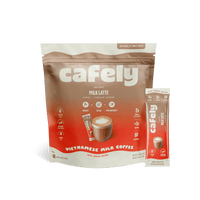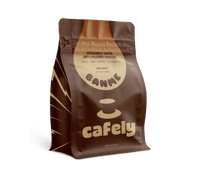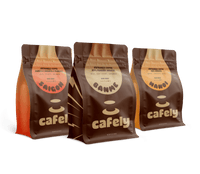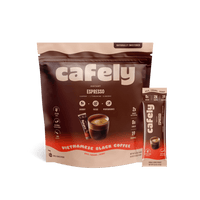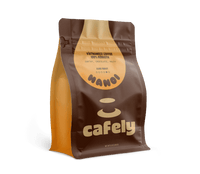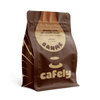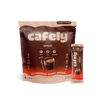Coffea liberica is a relatively rare species of coffee that’s grown in small quantities. It’s cultivated in Southeast Asia and parts of Africa (primarily), but large-scale plantations once covered several corners of the globe…
Liberica coffee used to make up around 50% of the world’s coffee production alongside Arabica. However, after just three short decades in the global coffee spotlight, its mass production ended. Now, Coffea liberica makes up an extremely small percentage of coffee production (less than 1%).
In this article, you’ll learn about the rise and fall of Liberica coffee and why this brew is better now than it has ever been…
What is Coffea liberica?

Coffea liberica is a species of coffee plant that’s less common and not as frequently consumed as the popular Coffea arabica (Arabica coffee) and Coffea canephora (Robusta coffee).
This species is native to western and central Africa, and plants can be found in large populations in Liberia. This is where it adopted its name, “Coffea liberica,” commonly known as “Liberian coffee.” The plants are tall, broad-leafed, and produce bulbous fruits with impressively large seeds (coffee beans).
At one time, Liberica coffee made up around half of the world’s coffee production alongside Arabica, but the species was traded off for the more resilient and easily processed Robusta species. Now, Coffea liberica makes up less than 1% of the world’s coffee production.
Liberian coffee is known for its full body and smoky, woody, and nutty notes. It has a similar flavor profile to Robusta coffee, but with a higher sugar content and lower caffeine levels, it’s far less bitter.
Though less popular in the global market, Liberica coffee is significant in local economies where it’s grown. It’s a “niche” coffee, and high-quality beans fetch a premium price due to their unique flavor and limited availability.
What Does Liberica Coffee Taste Like?
Liberica coffee has a unique and distinct flavor profile that sets it apart from the more common arabica and robusta coffees. Although this species once had a reputation for making a poor-quality brew, it was mostly down to the processing techniques of the time that under or overdried the beans before roasting.
Developments in harvesting techniques, post-harvesting processing, and artisan roasting approaches have greatly improved the quality and taste of modern-day Liberica coffee.
With that said, the quality of the Liberica beans, how it has been roasted, and how you decide to brew it will all affect the taste of the resulting cup. It’s important to source high-quality coffee and brew it correctly using a French press, drip filter, Aeropress, or espresso machine if you’re to experience its true flavor.
Liberica Coffee Flavor Notes
Here are some common flavor notes associated with Liberica coffee:
- Smoky — A deep, smoky flavor is often noted, giving the brew a rich character.
- Nutty — Some Liberica blends exhibit nutty notes of almond, hazelnut, and peanut.
- Woody/Earthy — Liberica coffee often has woody or earthy undertones.
- Fruity — Notes of jackfruit, cacao, and other tropical fruits can be detected — more so in medium-roasted blends.
- Floral — Light floral undertones can be detected in certain blends, especially those that use beans from the Philippines.
Liberica Coffee Caffeine Content
Liberica coffee beans have a lower caffeine content than both Robusta and Arabica.
The caffeine concentration found in Coffea liberica beans is around 1.23 grams per 100 grams [1]. Compared to Arabica (1.61 g/100 g) and Robusta (2.26 g/100 g), it’s pretty low.
Liberica Coffee Sugar Content
Liberica beans have a higher sugar content than Arabica and Robusta beans. It’s this high sugar content that makes it challenging to process post-harvesting. The sugars are excellent for the fermentation process but it’s incredibly easy to over-ferment or under-ferment the beans, with either outcome resulting in a poor-tasting coffee.
Coffea liberica beans that have been properly fermented will produce one of the naturally sweetest cups of black coffee on the planet. Roasted Liberica beans contain around 8 grams of sucrose per 100 grams, but this level can vary depending on how the beans are handled post-harvesting [2].
Taxonomy & Anatomy of Coffea liberica

Coffea liberica is a member of the Rubiaceae family in the kingdom Plantae (plants). This family is home to all the coffee species as well as other crop plants such as Cinchona pubescens (source of quinine), Mitragyna speciosa (Kratom), and Uncaria tomentosa (Cat’s Claw).
Unlike the popular Coffea arabica and robusta species, the discovery of Coffea liberica can’t be attributed to a single person. However, the species appears to have been recorded scientifically in 1872 when the species was introduced to Ceylon (modern-day Sri Lanka) as a coffee crop [3].
Taxonomy
- Kingdom: Plantae
- Division:Magnoliophyta (Angiosperms)
- Class:Magnoliopsida (Eudicots)
- Order:Gentianales
- Family: Rubiaceae
- Genus:Coffea
- Species: Liberica
Anatomy
Coffea liberica has several distinct growth characteristics that set it apart from other species in the Coffea genus. The plants are much larger. They’re taller and wider, have broader leaves, much larger fruits, and seeds (beans) that are twice the size of Arabica coffee beans.
These are the key anatomical features of Coffea liberica plants:
- Height — Coffea liberica plants are much taller than C. robusta and C. arabica plants. They’re capable of reaching 20 meters (66 feet) in height.
- Leaves — Coffea liberica leaves are large, leathery, and dark green. They range from 25 to 35 centimeters (9.8 to 13.8 inches) in length and around half as wide.
- Flowers — The flowers are white and grow in clusters, similar to most Coffea species.
- Fruits — The coffee cherries produced by Coffea liberica are twice the size of those produced by C. arabica and C. robusta. They’re green during growth, turning dark red to purple as they ripen.
- Seeds (Beans) — Coffea liberica beans are twice the size of Arabica beans. They have a unique asymmetrical shape and can be described as almond-like. They have tough skin and are creamy-white when raw, turning “coffee brown” once roasted.
The Origins of Coffea liberica: The Rise & Fall of Liberian Coffee
Coffea liberica is indigenous to West Africa and has notable wild populations in Liberia, Ghana, and Sierra Leone. Although it’s unknown when the species was first discovered and used to brew coffee, its cultivation and use date back to the late 1700s to early 1800s [4].
19th Century: The Rise of Coffea liberica
The widespread cultivation of Coffea liberica outside of West Africa began in the 1870s. It rose to prominence as a replacement for Coffea arabica in southern and Southeast Asia (most notably in Sri Lanka) [5].
At the time, many southern and Southeast Asian countries were experiencing a devastating outbreak of coffee leaf rust (Hemileia vastatrix). The leaf rust rapidly spread across the region from 1870 to around 1920 and annihilated much of the Arabica coffee crops [6]. This devastation forced plantations to find a more resilient coffee species to cultivate — Coffea liberica.
During the latter end of the 19th century, Coffea liberica sat alongside Coffea arabica as one of the main coffee bean crops [7]. The species was favored because it was not only robust but high-yielding, easy to cultivate, and simple to harvest. These traits were particularly appealing to those involved in the coffee industry, especially those invested in (the failing) Arabica production in southern and Southeast Asia at the time.
Once established in Asia, coffee sector stakeholders were so impressed with the Liberica coffee plants that it was widely believed the species could replace Arabica and widen the coffee-growing frontier. This was the notion due to Coffea liberica’s robustness, ease of growth, and ability to grow at low altitudes, unlike Coffea arabica, which requires particular growing conditions.
Although Liberica coffee never "replaced" Arabica, during the late 19th century, its cultivation did expand across several lowland regions. Coffea liberica plantations could be found across South America, the Caribbean, parts of Africa, Madagascar, India, Malaysia, Java, and even Australia up until the early 20th century.
So, what happened? How did such a widely cultivated coffee crop become so rare?
20th Century: The Fall of Coffea liberica
The global importance of Liberica coffee was extremely short-lived. It shared the bulk of the coffee market with Arabica coffee for just three short decades.
Part of the reason Coffea liberica lost its pedestal in the world of coffee was its uncharacteristic flavor profile. The consumer of the time was familiar with the bold sweetness of Arabica coffee. Unfortunately, the poor taste and low quality of Liberian coffee didn't quite cut it. With weak consumer demand comes dissatisfied merchants. The demand for Liberica beans wasn’t high enough.
To be fair to Coffea liberica, the flavor and quality issues were not down to the beans themselves but instead the post-harvesting processes of the time. This species has much larger fruits with dense outer skin (epidermis) and a thick pulp (mesocarp) which makes them difficult to de-seed. The seeds of the time were over or under-dried, resulting in a poor-quality bean.
The fact that Coffea liberica plants don't drop their fruits once ripe also played a part. This was originally considered an attribute for ease of harvesting, but it was later realized that many of the fruits had fermented to some degree, spoiling the coffee bean within. The long transport of these suboptimal beans in humid conditions also affected the quality, leaving many harvests tainted by over-fermentation and mold.
It wasn’t just the low demand for Liberica coffee that led to its demise. The fact that it wasn’t 100% resistant to the leaf rust that wiped out hundreds of Arabica plantations was also a factor. Although coffee leaf rust is rarely fatal to the species, it can affect production.
With these negative factors gnawing at the minds of plantation owners and coffee stakeholders, yet another replacement coffee species was required…
Present Day: Replaced By Robusta

Enter Coffea canephora (robusta coffee)...
The discovery of Coffea canephora (also known as Coffea robusta), its fast global distribution, and the rapid adoption of Robusta coffee blends quickly reduced Liberica coffee production.
Robusta coffee is more resilient, extremely resistant to leaf rust, easy to harvest and process, and lacks any particular flavor characteristics making it perfect for blending with Arabica. Replacing Coffea liberica with Coffea robusta in commercial coffee cultivation was an easy choice to make.
These factors, combined with the rapid expansion of Arabica production in Brazil in the early 20th century, put an end to the commercial cultivation of Liberica coffee.
Today, Coffea liberica makes up less than 1% of the world’s coffee production.
Arabica and Robusta coffee now dominate, with Coffea arabica accounting for around 60% of global coffee production and Coffea robusta accounting for around 40% [8].
Coffea liberica Cultivation Requirements
Some farms still cultivate liberica coffee. It’s sold in specialty blends aimed at aficionados looking to explore all that coffee has to offer.
You can also grow liberica coffee at home if you live in tropical or sub-tropical climates.
Here are the growing requirements for this exotic coffee plant:
Temperature
Coffea liberica thrives in tropical climates with consistent temperatures ranging from 20°C to 30°C (68°F to 86°F). It’s more tolerant to higher temperatures compared to Coffea arabica and can deal with climate fluctuations better.
Altitude
This species grows well at lower altitudes — from sea level up to around 1000 meters (3300 feet). It requires well-drained, fertile soils with a pH range of 5.5 to 6.5. Soil pH isn't essential for growth, but fruit production appears to be more prolific in this range.
Rainfall & Water
Rainfall is crucial for Coffea liberica, although there's some disagreement about exactly how much is required for a healthy plant.
Some cultivators have found the species to be resilient to periods of low rainfall whereas others have not. This is likely due to slight genetic differences between cultivars. Regardless, around 1,500 to 2,500 millimeters (59 to 98 inches) of annual rainfall is required.
Planting & Pruning
Coffea liberica plants are much larger than Arabica and Robusta plants — often growing up to 9 meters (30 feet) tall. They require more spacing, typically about 3 meters (10 feet) between plants. Regular pruning is necessary to manage height for more efficient harvesting.
Pest & Disease Control
This species is more disease-resistant than Coffea arabica. However, it’s still susceptible to leaf rust (less severe) and pests like the coffee berry borer (Hypothenemus hampei). Pest management strategies are important for maintaining healthy Liberica crops.
FAQs: Coffea liberica & Other Types of Coffee
Learn more about Coffea liberica and other types of coffee in the answers to these frequently asked questions we've received:
1. What's the Difference Between Arabica and Liberica Coffee?
Arabica and Liberica coffee are made from the beans of two different species — Coffea arabica and Coffea liberica. Although these two species belong to the same genus, they produce beans with different characteristic traits.
- Arabica coffee has a delicate and complex flavor, often exhibiting fruity, chocolatey, and nutty notes. Arabica coffee is smooth and sweet. The beans contain less caffeine and more sugar than Liberica. It’s the most widely consumed coffee, making up 60% of global production.
- Liberica coffee is more robust and bold in flavor, exhibiting smoky, woody, nutty, and floral notes. It has a heavier and more full-bodied taste and is described as “earthy” by some. Liberica beans are larger than Arabica beans and contain less caffeine and more sugar.
2. What's the Strongest Type of Coffee?
The strongest known coffee species with the highest caffeine content is Coffea robusta. The beans of this plant contain 68.6 to 81.6 grams of caffeine per kilogram. Compared to Coffea liberica and even Coffea arabica, that's pretty strong.
The average brew of robusta coffee contains around 3% caffeine (around 200 to 265 mg per serving). However, this can be significantly higher depending on the cultivar, roast, and extraction method.
Ristretto is the strongest coffee type. This extraction method is similar to espresso. Water is still pulled through finely ground beans like an espresso, but less water is used to make for a more concentrated shot of coffee. Like espresso with its high caffeine level, ristretto robusta coffee also creates a cup with one of the highest caffeine concentrations. However, this method of extraction is rarely combined with robusta because the resulting shot is far too bitter for most people's palates.
3. Is Robusta Good Coffee?
Robusta (Coffea robusta) is often tarnished as the “inferior sibling” of arabica coffee in the Western world because of its bitter taste and less complex flavor. However, it's extremely popular in Southeast Asian countries such as Vietnam, and it makes a better cup of coffee than most people believe. There are actually many ways of making good cup of coffee using robusta, from espresso shots to phin-brewed Vietnamese coffee.
Despite its reputation, Robusta can provide a satisfying and complex cup of coffee when properly processed and brewed.
References:
- Ling, L. S., Daud, N. I. N., & Hassan, O. (2001). Determination of coffee content in coffee mixtures. Malaysian Journal of Analytical Sciences, 7(2), 327-332.
- Karyantina, M., Surulloh, A., & Suhartatik, N. (2024). Antioxidant activity kombucha coffee (Coffee spp) with variation concentration and type. In BIO Web of Conferences (Vol. 99, p. 02009). EDP Sciences.
- Cruwell, G. A. (1878). Liberian Coffee in Ceylon: The History of the Introduction and Progress of the Cultivation Up to April 1878... and a Series of Letters on Liberia by the Late Mr. GA Crüwell... Compiled from the Columns of the" Ceylon Observer.". AM & J. Ferguson.
- McCook, S. in Comparing Apples, Oranges, and Cotton. Environmental Histories of the Plantation (ed F Uekötter) 85–112 (Campus Verlag, 2014).
- Cruwell, G. A. Liberian Coffee in Ceylon: The History of the Introduction and Progress of the Cultivation up to April 1878. (A.M. & J. Ferguson, 1878).
- Talhinhas, P., Batista, D., Diniz, I., Vieira, A., Silva, D. N., Loureiro, A., ... & do Céu Silva, M. (2017). The coffee leaf rust pathogen Hemileia vastatrix: one and a half centuries around the tropics. Molecular plant pathology, 18(8), 1039.
- Freeman, W. & Chandler, S. The World’s Commercial Products. (Sir Isaac Pitman and Sons Ltd., 1907)
- Baker, P. S. (2014). Global coffee production and land use change. Association Scientifique Internationale pour le Café.
